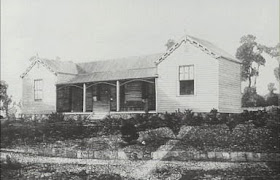 |
| Braemar c1892 |
Thomas Garrett, his wife Helen and their family of three girls and four boys probably arrived in Springwood during the first half of 1898. In August of that year his name appeared for the first time in the columns of the Nepean Times, when he was elected a Vice President of the Springwood Cricket Club. He was born in Wollongong on 26 July 1858, the second son of politician and newspaper proprietor the Hon. Thomas Garrett and his first wife Mary Ann Elizabeth (nee Creagan). Educated at Newington College, he later studied law and was admitted as a solicitor in the Supreme Court, eventually becoming registrar of probates in 1890, curator of intestate estates in 1896 and public trustee in 1914. It was, however, his talent as a cricketer that brought him to a wider public notice. After showing early ability at school, he went on to play with distinction for both New South Wales and Australia.
In 1877 the 18-year-old Garrett was chosen to play for Australia in Melbourne against James Lillywhite’s team of professionals, a match that has come to be considered the first Test against England. He went on to tour England three times—in 1878, 1882 and 1886—and represented Australia in seven Test series at home, scoring 339 runs and taking 36 wickets. On the 1882 tour of England he played in the famous match at The Oval when Australia defeated England for the first time on English soil, provoking the Sporting Times to report the death of English cricket in its next issue. ‘The body’, it declared, ‘will be cremated and the ashes taken to Australia’.
Bearded, tall and lean, Garrett was primarily recognised as a right-arm, slightly more than medium pace bowler with an ability to swing the ball either way. But he was no slouch with the bat and also proved a shrewd and successful captain of New South Wales. At the age of 38 in 1897 he scored 131 runs against a South Australian team that included the champion fast bowler Ernest Jones.
In 1879, Thomas married Helen Alice Maude, the daughter of sea captain John Applewhaite. Between overseas visits he fathered several children: Mary Emily was born in 1880, Lucy Alice in 1882, Maude in 1884, John H. in 1888, Eric R. in 1890 and Frederick C. in 1892.
The Garrett family seems to have resided in Springwood for a period of about ten years. When they first arrived in 1898 they moved into Braemar on the Western Road (now Macquarie Road). By 1908, however, the family had moved to the western end of the town, to Stanway in Railway Parade (now also part of Macquarie Road).
During their time in Springwood, judging by reports of their activities in the Springwood news columns of the Nepean Times, the Garretts were actively involved in the life of the community. Father and sons were members of both the cricket and rugby football clubs. Thomas served as a Vice President of both and also helped to establish a golf club in the town in 1905. In 1909–10, when Springwood Cricket Club won the Nepean District premiership, three of Thomas’s sons were in the team, one of them as captain. Records of the Springwood Progress Association list Thomas as a member in 1893–4 and again in 1905–6.
Mother and daughters, too, were reported in various capacities at fetes organised by both the Christ Church of England and Springwood Ladies College, where the girls attended school. Thomas Garrett also acted as honorary auditor for a number of local organisations including the Anglican Church, the Progress Association and the School of Arts.
Their residency came to a temporary end in 1902. On 3 May 1902 the Nepean Times announced the departure of the family, who had been residents for four years. On the day of their departure a large number of friends gathered on the railway platform to see them off and wish them well for the future. However their absence was short lived and it was announced again, via the Nepean Times (April 1903), that Tom Garrett the veteran cricketer was coming to reside again in the mountains somewhere between Valley Heights and Springwood. Helen, Lucy and Mary Elsie are listed on the 1903 electoral roll. In May 1903 the Garretts settled into Braemar once again, entering quickly into the social and sporting life of the town.
At some point in time after 1903 they appear to have moved back into the Crane’s residence Stanway, as a 1908 Nepean Times advertisement for Springwood Heights Estate indicates that the property subdivision was located between Hoare’s (Homedale) and Garrett’s (Stanway).
Over the next few years Thomas acted as the registrar for the area. Together with Mr J.D. Ewens he was auditor for the books of the Progress Association, and in 1909 he audited the books of the Springwood School of Arts Institute. During that same year the Blue Mountains Echo was full of praise for the sons of Thomas and Helen Garrett when they reported that a cricket match played between Emu Plains and Springwood resulted in a win for the later. The paper stated that the ‘Garrett brothers’ had played most successfully for Springwood.
While it is unclear exactly when the family left Springwood it was possibly some time in 1912, for the Garrett name does not appear in the local electorate on the 1913 Commonwealth Electoral Roll.
Thomas William Garrett died at Warrawee in Sydney at the age of 85 years on 6 August 1943. He was cremated at the Northern Suburbs Crematorium after a service at St James Church, Turramurra.
John Low
From: The Making Of A Mountain Community: A Biographical Dictionary of the Springwood District













